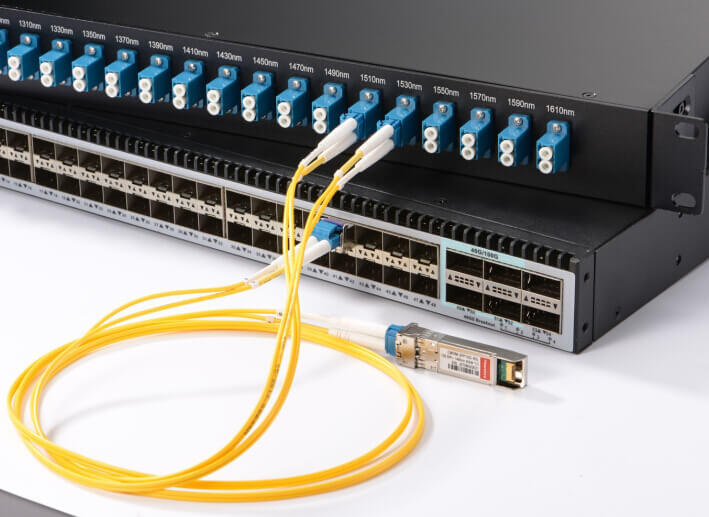Specified SFP, SFP+ and XFP Optical Module
Ⅰ What is SFP Optical Module
SFP is an abbreviation of SMALL FORM PLUGGABLE, which can be simply understood as an upgraded version of GBIC. The SFP module is half the size of the GBIC module, which can be configured with more than double the number of ports on the same patch panel. The other functions of the SFP module are basically the same as the GBIC.
Some switch manufacturers regard that SFP modules are miniaturized GBIC (MINI-GBIC). GBIC is an abbreviation of Gigabit Interface Converter, which is an interface device that converts gigabit electrical signals into optical signals. The GBIC can be designed for hot swapping. GBIC is an interchangeable product that meets international standards. Gigabit switches designed with GBIC interface have a large market share in the market due to flexible interchangeability.
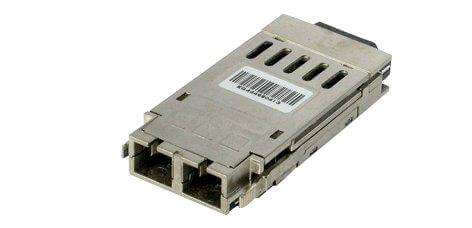
GBIC modules are divided into two categories:
The first is the GBIC module used by the common cascade to realize the common connection with other switches. The second is to stack dedicated GBIC modules to achieve redundant connections with other switches.
The SFP module further compresses size and power by placing CDR and electrical dispersion compensation outside of the module.
SFP standardization
SFP transceivers are regulated by a Multilateral Agreement (MSA) between competing vendors. The SFP is designed according to the GBIC interface, allowing for a larger port density than the GBIC (the number of transceivers per inch on the side of the motherboard), so the SFP is also called “mini-GBIC”.The related small-sized transceiver (SFF transceiver) is smaller in size than the SFP, but the SFF is soldered to the motherboard as a pin through-hole device instead of being inserted into the side card slot.
SFP Style
SFP transceivers come in a variety of different transmit and receive types, and users can select the appropriate transceiver for each link to provide “optical performance” based on the available fiber type (eg multimode fiber or single mode fiber). Available optical SFP modules are generally classified into the following categories: MMF (SX) at 850 nm wavelength / 550 m distance, SMF (LX) at 1310 nm wavelength / 10 km distance, XD at 1550 nm wavelength / 40 km distance, 80 km distance ZX, EX or EZX at a distance of 120 km, and DWDM. The SFP transceiver also provides a copper interface that allows host devices designed primarily for fiber optic communications to communicate over UTP network cables. There are also wavelength division multiplexing (CWDM) and single fiber “two-way” (1310/1490 nm wavelength up/down) SFP.
Fiber Style
The optical fiber is divided into two types: multimode fiber and single mode fiber. Among them, multimode fiber is widely used for short-distance communication because of its relatively low cost and simple construction. Multimode fiber is divided into 50um core diameter and 62.5um. There are two core diameters, of which 62.5um is more common, but the performance is not as good as 50um.
Single-mode fiber is generally used for long-distance communication, with a core diameter of 9um and a transmission distance of 10km, 20km, 70km, and 120km on a single-mode fiber. General switch manufacturers only offer 10 km and 70 km models on a single mode. The 20 km product can effectively save the overall cost of the system integrator’s specific network solution. The 120 km product is used in special long operating environments.
Difference Types of SFP
SFP optical modules usually use dual LC interfaces, in addition to single-core SFP optical modules. From the rate and fiber type, it can be divided into four types: single-mode multi-mode and single-mode multi-mode.
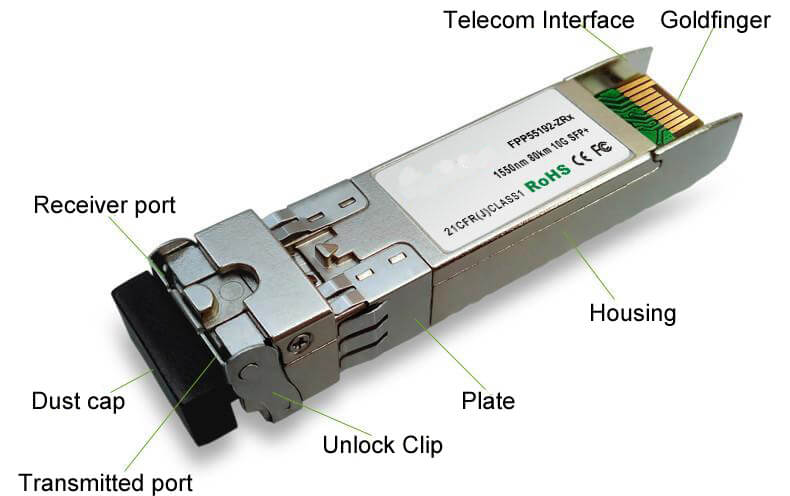
Ⅱ The difference between SFP multimode and single mode
At present, I have encountered several SFP problems on the project, and there are some problems related to the type of optical module. Actually, I have found some multi-mode and single-mode data.
According to the wavelength, there are 850nm/1310nm/1550nm/1490nm/1530nm/1610nm, the wavelength of 850nm is SFP multimode, and the transmission distance is below 2KM;
The wavelength of 1310/1550nm is SFP single mode, the transmission distance is above 2KM, relatively speaking, the price of these three wavelengths is cheaper than the other three.
If the bare module is not easily confused, the manufacturer will distinguish the color of the pull ring. For example, the black pull ring is multimode, the wavelength is 850 nm, and the blue, yellow, and purple pull rings are single mode. It is 1310 nm, 1550 nm, and 1490 nm.
Multimode:
Almost all multimode fibers are 50/125μm or 62.5/125μm in size, and the bandwidth (the amount of information transmitted by the fiber) is usually 200MHz to 2GHz. Multimode optical transceivers can transmit up to 2 kilometers through multimode fiber. A light emitting diode or a laser is used as a light source. The pull ring or outer body is black in color.
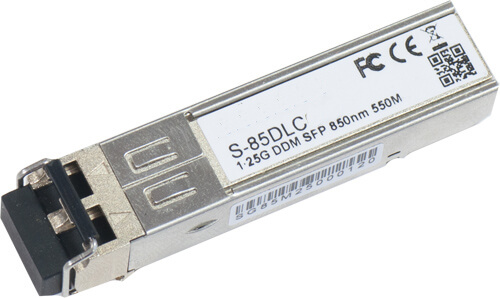
Singlemode:
The size of the single mode fiber is 9/125 μm and has infinite bandwidth and lower loss characteristics than the multimode fiber. Single-mode optical transceivers are often used for long-distance transmission, sometimes up to 100 kilometers. LEDs with narrower LD or spectral lines are used as the light source. The color of the pull ring or outer body is blue, yellow or purple.
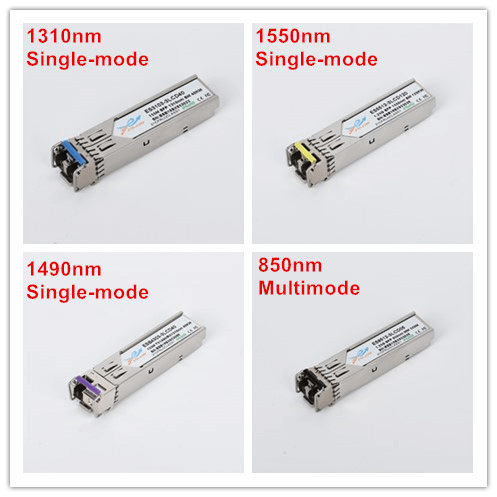
Difference and connection
Single-mode fiber is cheap, but single-mode devices are much more expensive than comparable multimode devices. Single-mode devices typically operate on both single-mode fibers and multimode fibers, while multimode devices are limited to operation on multimode fibers.
With the close of single-mode and multi-mode SFP optical modules this year, the adoption of single-mode optical cables and single-mode modules has become mainstream. Single mode is significantly better than multimode type in use.
Ⅲ Difference between SFP and BIDI SFP
As is well known, a common SFP module usually has two ports, one for the TX port to transmit signals and the other for the RX port to receive signals. Unlike common SFP modules, the BiDi SFP module has only one port that uses an integral WDM coupler to transmit and receive signals on a single fiber.
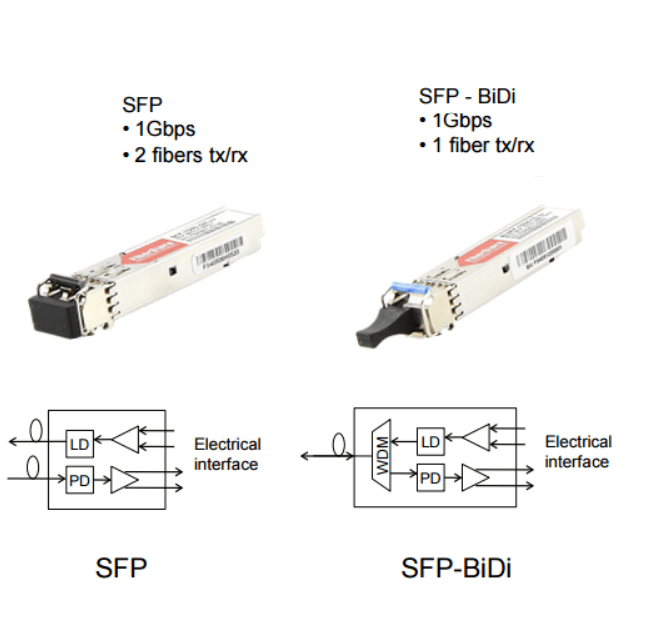
SFP and BiDi SFP Connection Method
All SFP modules must be used in pairs. For common SFPs, we should connect two SFPs with the same wavelength. For example, we use 850nm SFP at one end, then we must use 850nm SFP at the other end.
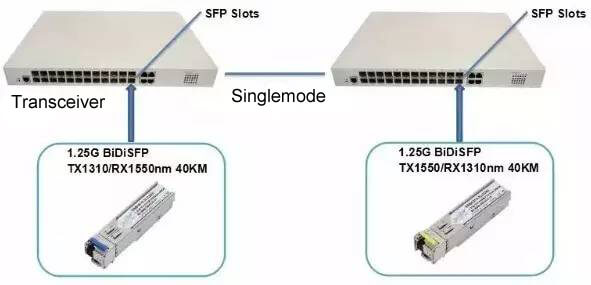
For BiDi SFP, because it uses different wavelengths to transmit and receive signals, we should connect two BiDi SFPs with opposite wavelengths together. For example, if we use TX1310/RX1550nm BiDi SFP at one end, then on the other end we should use TX1550/RX1310nm BiDi SFP.
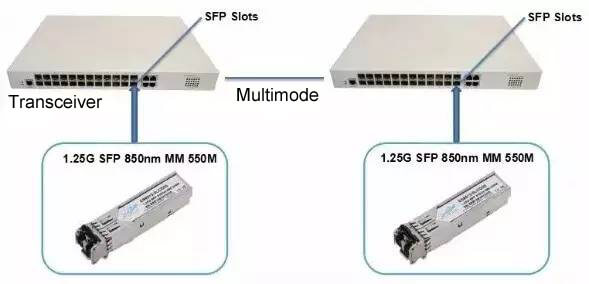
BiDi SFP Application
Currently, BiDi SFP is mainly used for fiber-to-the-home deployment of P2P (peer-to-peer) connections. An FTTH/FTTB active Ethernet network consists of a central office (CO) connected to a client device (CPE). BiDi SFP allows for bidirectional communication on a single fiber using wavelength division multiplexing, which makes CO and CPE connections simpler.
Ⅳ Difference between SFP, SFP+ and XFP
The 10G module has undergone development from 300Pin, XENPAK, X2, and XFP, and finally realized the transmission of 10G signals in the same size as SFP. This is SFP+. SFP+ meets the high density requirements of optical modules due to its advantages of miniaturization and low cost. It has gradually replaced XFP as the mainstream of the 10G market.
SFP Package-Hot-swappable small package modules, the current maximum speed is up to 4G, and LC interfaces are commonly used.
SFP+ Package- Standard package, working speed is 10G, can meet the application of Ethernet 10G.
XFP Package- A standardized package for serial 10G optical transceiver modules.
SFP+ module advantages are that, firstly, SFP+ has a more compact form factor (same size as SFP) than X2 and XFP packages. Secondly, SFP+ can be directly connected to the same type of XFP, X2, XENPAK. Difference between SFP and SFP+1. SFP and SFP+ have the same dimensions; 2. The maximum rate of SFP is up to 4G, and the rate of SFP+ is 10G.3. SFP protocol specification: IEEE802.3, SFF-8472; 4. SFP+ supports digital diagnosis.
Difference between SFP and XFP
- SFP+ and XFP are both 10G fiber modules and can communicate with other types of 10G modules;
- SFP+ is smaller than the XFP appearance size;
- Because of its smaller size, SFP+ moves the signal modulation function, serial/deserializer, MAC, clock and data recovery (CDR), and electronic dispersion compensation (EDC) functions from the module to the motherboard card;
- XFP compliant protocol: XFP MSA protocol;
- SFP+ compliant protocols: IEEE 802.3ae, SFF-8431, SFF-8432;
6. SFP+ is a more mainstream design;
- SFP+ protocol specification: IEEE 802.3ae, SFF-8431, SFF-8432.
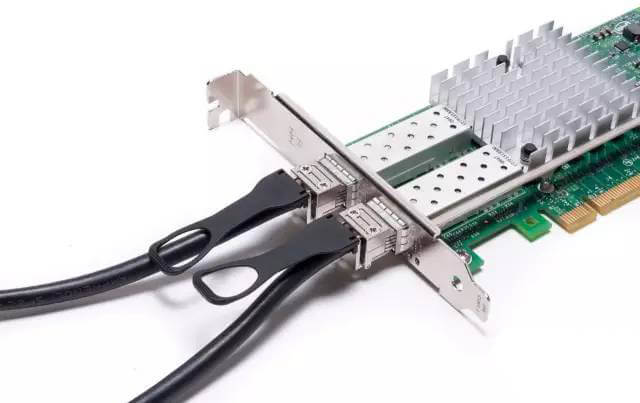
Ⅴ BiDi SFP Advantages
With the rapid development of communication, the demand for wireless bandwidth in the market is getting higher and higher, so many optical communication product manufacturers continue to develop new products to meet market demand. The BiDi SFP+ optical module is also produced in this case. Let’s share the use of the BiDi SFP+ optical module.
BIDI is a single-fiber bidirectional optical module. That is BiDi (Bidirectional). The BIDI optical module has only one port, which is filtered by the filter in the optical module, and simultaneously performs the transmission of the 1310 nm optical signal and the reception of the 1550 nm optical signal, or vice versa.
Therefore, such modules must be used in pairs, and their greatest advantage is to save fiber resources. The commonly used wavelengths of BIDI optical modules are TX1310/RX1550nm; TX1310/RX1490nm; TX1550/RX1490nm.
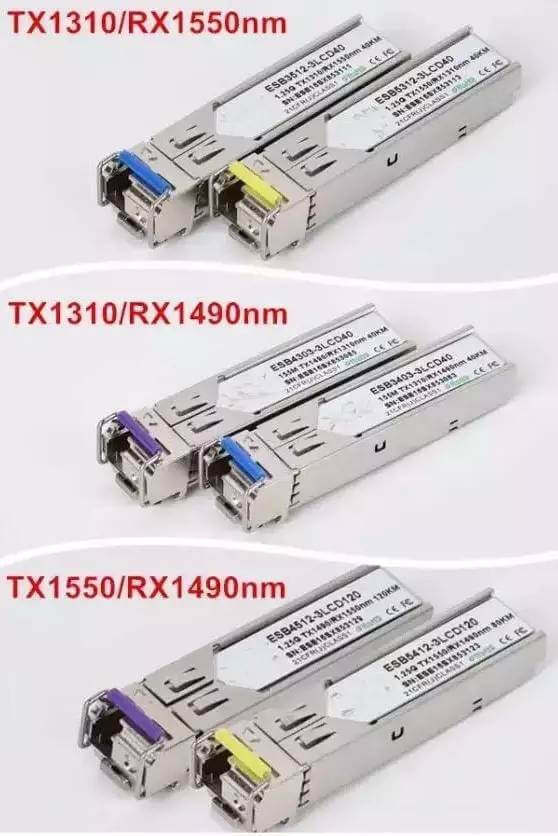
SFP+ Optical Module (10 Gigabit Small Form Factor Pluggable) is a hot-swappable, communication protocol-independent optical transceiver that typically transmit light at wavelengths of 850 nm, 1310 nm or 1550 nm for 10 Gbps of SONET/SDH, Fiber Channel, gigabit Ethernet, 10 gigabit Ethernet, and other applications, including DWDM links.
Therefore, the BiDi SFP+ optical module was developed based on CPRI (Common Public Radio Interface) and OBSAI (Open Base Station Architecture Plan) standards. The BiDi SFP+ optical module is available in SFP+ small package and meets SFF-8431 MSA, SFF-8432 and SFF-8472 protocol standards, and supports single-fiber bidirectional transmission. Not only that but also support different transmission distances, including 10km, 20km and 40km. In addition, the SFP+ module operating temperature range is very wide, which is from 0 °C to 75 °C can be easily operated, becoming the first choice for indoor and outdoor communication networks, providing high-speed, stable signal transmission channels.
In summary, the advantages of BiDi SFP+ optical modules are that transmission distance of the wavelength TX1270/RX1330nm is 10KM/20KM/40KM/60KM; the transmission distance of the wavelength TX1490/RX1550nm is 80KM. Single power supply +3.3V power supply LVPECL/PECL data interface Operating temperature 0°C-70°C and meet GR-468-CORE requirements Meets Laser Class 1, meets IEC60825-1 requirements.
BiDi SFP+ optical modules are widely used in existing wireless communication base stations and new wireless communication base stations, and provide a high-speed and stable signal transmission bridge between communication base stations and fiber-optic antennas.

